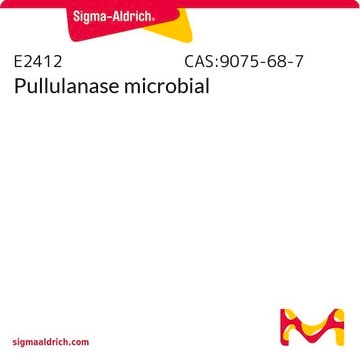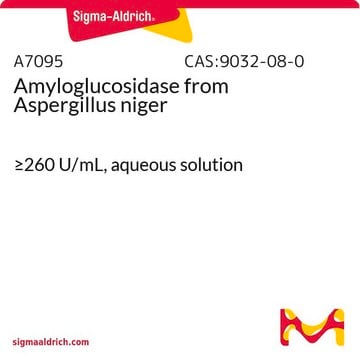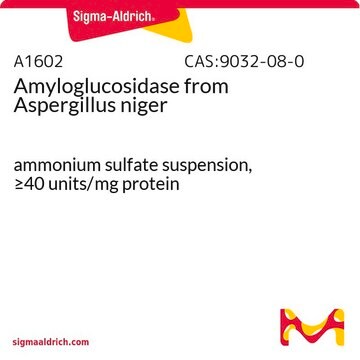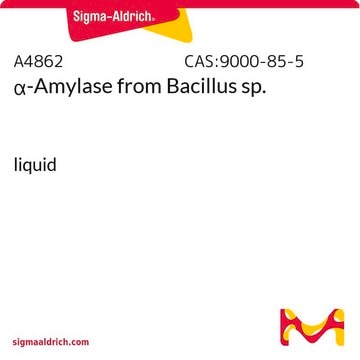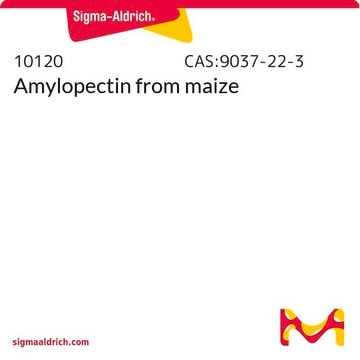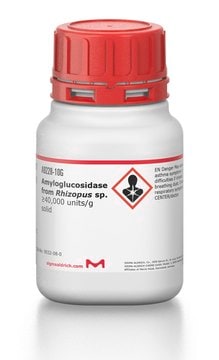08124
Isoamylase from Pseudomonas sp.
ammonium sulfate suspension, ≥10,000,000 units/mg protein
Sign Into View Organizational & Contract Pricing
All Photos(1)
About This Item
Recommended Products
form
ammonium sulfate suspension
Quality Level
specific activity
≥10,000,000 units/mg protein
storage temp.
2-8°C
Looking for similar products? Visit Product Comparison Guide
Related Categories
Application
Isoamylase from Pseudomonas sp. has been used in starch debranching and to measure the chain-length distributions.
Biochem/physiol Actions
Pseudomonas amyloderamosa is considered a popular source of isoamylase. In the presence of a surfactant, this isoamylase produces a series of maltooligosaccharides. Immobilized isoamylase makes it applicable with a polysaccharide matrix composed of agarose, cellulose, and raw corn starch.
Catalyzes the hydrolysis of (1-6)-α-D-glucosidic branch linkages in glycogen, amylopectin and their β-limit dextrins.
Unit Definition
One unit causes an increase in A610 of 0.1 in 1 hour using a homogenized solution of rice starch as a substrate (pH 3.5, 40°C)
Analysis Note
≥10 MU/mg protein
Signal Word
Danger
Hazard Statements
Precautionary Statements
Hazard Classifications
Acute Tox. 3 Dermal - Acute Tox. 4 Inhalation - Acute Tox. 4 Oral - Aquatic Chronic 2
Storage Class Code
6.1D - Non-combustible acute toxic Cat.3 / toxic hazardous materials or hazardous materials causing chronic effects
WGK
WGK 2
Flash Point(F)
Not applicable
Flash Point(C)
Not applicable
Choose from one of the most recent versions:
Already Own This Product?
Find documentation for the products that you have recently purchased in the Document Library.
Customers Also Viewed
In vitro amylase hydrolysis of amylopectins from cereal starches based on molecular structure of amylopectins
Guo Li
Food Hydrocolloids, 77, 238-247 (2018)
Wenwen Li et al.
Carbohydrate polymers, 270, 118363-118363 (2021-08-09)
Finding an efficient and eco-friendly solution for starch dissolution has attracted considerable attentions in recent years. This study investigated the structural characteristics, and degradation behavior of corn starch in KOH/thiourea aqueous solution by the comparison with DMSO/LiBr and 1-allyl-3-methylimidazolium chloride
Digestion properties of corn starch modified by $\alpha$-D-glucan branching enzyme and cyclodextrin glycosyltransferase
Li Y, et al.
Food Hydrocolloids, 89, 534-541 (2019)
Enzymatic conversions of starch
Tomasik P and Horton D
Advances in Carbohydrate Chemistry and Biochemistry, 68, 59-436 (2012)
Hongjie An et al.
Journal of food science, 76(1), N11-N14 (2011-05-04)
Starch debranching is fundamental for understanding the structure-function relationships of starch. In this paper, atomic force microscopy (AFM) was used to investigate potato starch by isoamylase [EC 3.2.1.68] debranching at nanometer scale. The hydrolysates were separated by gel-permeation chromatography and
Our team of scientists has experience in all areas of research including Life Science, Material Science, Chemical Synthesis, Chromatography, Analytical and many others.
Contact Technical Service